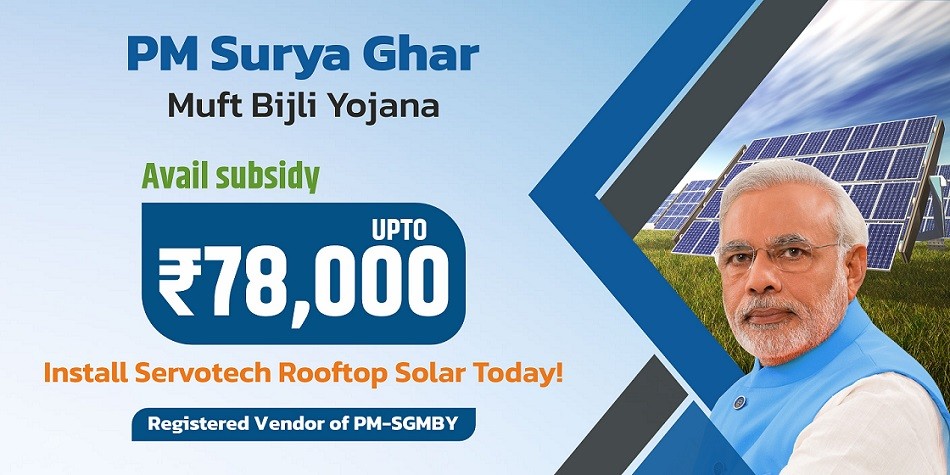
In recent years, India has witnessed a significant push towards renewable energy, with the government introducing various initiatives to promote solar energy adoption. One such initiative is the PM-SURYAGHAR (Pradhan Mantri – Solar Rooftop Scheme), aimed at making solar energy accessible and affordable for residential households across the country. This blog delves into the details of the scheme, its benefits, eligibility criteria, and the step-by-step process to avail the subsidy.
Understanding the PM-SURYAGHAR Scheme
Launched by Prime Minister Narendra Modi on 15th February 2024, the PM-SURYAGHAR scheme is part of India’s commitment to achieving a sustainable and green energy future. The scheme offers substantial subsidies to residential consumers for installing rooftop solar systems, thereby reducing their electricity bills and contributing to the nation’s renewable energy goals.
According to the official guidelines, the subsidy structure is as follows:
- ₹30,000 per kW for the first 2 kW of the system
- ₹18,000 per kW for additional capacity up to 3 kW
- Maximum subsidy of ₹78,000 for a 3 kW system
This means that a residential consumer opting for a 3 kW rooftop solar system can avail a total subsidy of ₹78,000, significantly reducing the upfront cost of installation.
Eligibility Criteria
To avail the benefits of the PM-SURYAGHAR scheme, residential consumers must meet the following eligibility criteria:
- Ownership of the property: The applicant must own the rooftop where the solar system will be installed.
- Grid connection: The property should be connected to the electricity grid.
- System capacity: The subsidy is applicable for systems ranging from 1 kW to 3 kW.
- Non-eligibility for previous subsidies: The applicant should not have previously availed any subsidy under the rooftop solar program.
Benefits of the Scheme
The PM-SURYAGHAR scheme offers several advantages to residential consumers:
- Reduced electricity bills: By generating their own electricity, consumers can significantly lower their monthly electricity expenses.
- Government subsidy: The upfront cost of installation is reduced due to the subsidy, making solar energy more affordable.
- Environmentally friendly: Solar energy is a clean and renewable source of power, contributing to a reduction in carbon footprint.
- Increased property value: Homes equipped with solar systems are often valued higher in the real estate market.
Step-by-Step Process to Avail the Subsidy
- Select an MNRE-approved vendor: Choose a vendor empanelled with the Ministry of New and Renewable Energy (MNRE) and your state’s electricity distribution company (DISCOM).
- Site survey: The vendor will conduct a site survey to assess the feasibility of installing a rooftop solar system.
- Documentation: Submit the necessary documents, including:
- Proof of identity (Aadhaar/PAN)
- Proof of address (electricity bill)
- Bank account details
- Roof ownership proof
- Application submission: The vendor will submit the application to the DISCOM on your behalf.
- Installation: Upon approval, the vendor will install the rooftop solar system.
- Net metering: A net meter will be installed to measure the electricity generated and consumed.
- Subsidy disbursement: After installation, the subsidy amount will be credited directly to your bank account.
Real-World Example
Consider a residential consumer opting for a 3 kW rooftop solar system:
- Total cost of the system: ₹1,95,000
- Government subsidy: ₹78,000
- Amount to be paid by the consumer: ₹1,17,000
This example illustrates how the PM-SURYAGHAR scheme can make solar energy adoption more affordable for residential consumers.
Recent Developments and News
The PM-SURYAGHAR scheme has garnered significant attention, with numerous states implementing additional incentives to encourage solar adoption. For instance, in Rajasthan, over 20,000 electricity consumers registered for the 150-unit free solar power scheme within two days, highlighting the growing interest in solar energy solutions The Times of India.
Conclusion
The PM-SURYAGHAR scheme is a significant step towards promoting renewable energy and making solar power accessible to residential consumers across India. By understanding the subsidy structure, eligibility criteria, and application process, consumers can make informed decisions about adopting solar energy solutions for their homes.
For more detailed information and to apply for the subsidy, visit the official PM-SURYAGHAR website: https://pmsuryaghar.gov.in/ This is your first post. Edit or delete it, then start writing!
Thank you for taking the time to read this article
📞 Contact: +91 86608 21746
📧 Email:brindavansolutions@gmail.com
🏢 Company: Brindavan Solutions, Bangalore
Interested in solar? Get your free proposal and site survey with just one click! https://wa.me/918660821746
